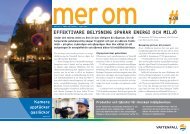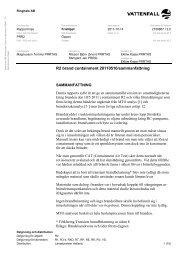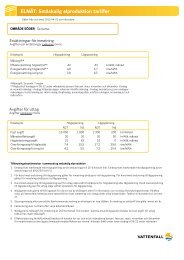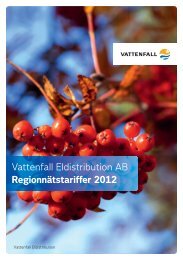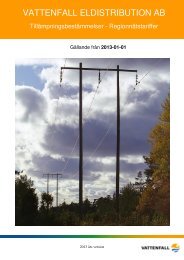This environmental impact assessment for Kriegers flak ... - Vattenfall
This environmental impact assessment for Kriegers flak ... - Vattenfall
This environmental impact assessment for Kriegers flak ... - Vattenfall
Create successful ePaper yourself
Turn your PDF publications into a flip-book with our unique Google optimized e-Paper software.
The investigations at both wind farms showed that<br />
the birds make way <strong>for</strong> the turbines well in advance.<br />
At Horns Rev, a change in ß ight path was registered<br />
at a distance of between 400 and 1 000 metres. At<br />
Nysted, the ß ight path changed already at a distance of<br />
3 000 metres during day time and 1 000 metres during<br />
night time. The differences between the wind farms is<br />
probably explained by the different species registered.<br />
The investigations were conducted during one year,<br />
albeit not during days with bad visibility (fog/rain).<br />
Further, only larger water fowl and day migrating birds<br />
could be registered. The results from the investigations<br />
should, there<strong>for</strong>e, be treated with caution.<br />
The collision risk depends on several different<br />
factors. As mentioned above, the weather has a great<br />
<strong>impact</strong> but the risk is also due to the species. An investigation<br />
of 190 bird species that have collided with<br />
a Danish lighthouse, show that Þ ve species made up<br />
<strong>for</strong> 75 % of the casualties (Hansen, 1954). These were<br />
Eurasian skylark, song thrush, redwing, dipper and<br />
European robin. About 90 % came from 14 different<br />
species, all of which were night ß yers. Of all birds<br />
observed, very few were day ß yers and only three were<br />
thermal ß yers.<br />
IfAÖ has in its report estimated annual collisions<br />
to 1 000. The risk of water fowl, such as ducks, geese,<br />
eider ducks, seagulls, terns and loons, would collide<br />
with wind turbines is considered as low. As thermal<br />
ß yers normally ß y at much higher heights and as their<br />
eyesight is well developed, the risk <strong>for</strong> collision is low.<br />
In addition, ß ights over open sea by thermal ß yers<br />
CONSEQUENSES OF THE WIND FARM 131<br />
occurs seldom. Most collision victims will most likely<br />
be middle distance ß yers with very large breeding<br />
stocks in Scandinavia, <strong>for</strong> example Eurasian skylarks,<br />
thrushes and dippers. In relation to breeding stocks of<br />
Scandinavian night ß yers (500 – 600 million), the annual<br />
maximum mortality quota is estimated to 0,002%.<br />
The IfAÖ considers that this quota will not have any<br />
negative <strong>impact</strong> on migrating birds (page 117, stocks<br />
decrease).<br />
Jan Pettersson has, on behalf of Sweden Offshore,<br />
estimated the annual collision (Attachment 8.4). Jan<br />
Pettersson has estimated the number of annual collisions<br />
to 48, a much lower number than that of the<br />
IfAÖ.<br />
b) Disturbance of staging and <strong>for</strong>aging water fowl<br />
Wind turbines may also frighten breeding, staging and<br />
<strong>for</strong>aging birds. The effect varies <strong>for</strong> different species.<br />
Seagulls and terns are regularly observed at Horns<br />
Rev. During the construction phase, the frightening<br />
effect may become big due to transports and construction<br />
work. There are currently no studies made on the<br />
<strong>impact</strong> of noise and vibrations on birds.<br />
c) Barrier effect<br />
Here, barrier effect means that migrating birds to<br />
avoid the wind farm make a detour in their ß ight. As<br />
the planned wind farm will occupy such a large area,<br />
it is conceivable that migrating birds will act similarly<br />
to the wind farm as to islands, namely to ß y over the<br />
area at several hundred metres height. <strong>This</strong> type of<br />
behaviour has been registered at onshore objects with,<br />
<strong>for</strong> example common scoter, loons and long-tailed duck<br />
(Bergman & Donner, 1964, Berndt & Busche, 1993).<br />
The above studies at Horns Rev, Nysted and Utgrunden<br />
have shown that large scale wind farms do have barrier<br />
effects even if there are species speciÞ c differences.<br />
For common scoters and loons, wind farm are examples<br />
of barriers whilst eider ducks ß y through, although<br />
if mainly around them. Wind farms are no barriers <strong>for</strong><br />
seagulls, terns and most thermal ß yers, as the latter<br />
often ß y higher than the wind turbines.<br />
The important question regarding barrier effects, is<br />
whether the detour gives rise to any relevant increase<br />
in energy consumption. Considering the high, natural<br />
variations of ß ights and their total distance, IfAÖ estimates<br />
the extra load <strong>for</strong> the affected species as minor.





